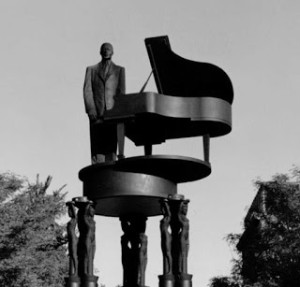I squired my sister Sue around Harlem a couple of Sundays ago after visiting her art studio on 118th Street. We stopped at Sylvia’s for brunch; bought fruit at an open air stand at the fork between St. Nicholas Avenue and St. Nicholas Way; went by Coleman Hawkins’ apartment building on Edgecombe Avenue; and toured Cathedral of St. John the Divine. Our last stop was the multi-level sculpture of Duke Ellington at 5th Ave and 110th Street. It was erected in 1997 and was the first public monument in New York dedicated to an African American.

Billy Taylor will be honored today 28 blocks north of the Ellington monument in a ceremony re-naming 138th Street between Fifth and Madison Dr. Billy Taylor Way. UMass alums can take special pride in this honor, as Dr. T not only earned his Masters and Ed.D at UMass, but held the Music Department’s Wilbur D. Barrett Chair and established the Jazz in July summer music program, which he directed and starred in for many years. Here’s Dr. T’s capsule symposium about improvising on “They Can’t Take That Away From Me.”
Video: https://www.youtube.com/watch?v=oVvF7S2hW5U
It was Taylor who made my first visit to Amherst for the prospect of attending the university unforgettable. After meetings on the campus, I stopped at Augie’s, a former newsstand on North Pleasant, and who but Billy Taylor was exiting as I entered. Dr. T was always dressed for prime time, and on this occasion had a Burberry trenchcoat draped across his left arm. I recognized him immediately, blurted out his name, and got the kind of warm greeting that I would come to experience many times over in his company. As I turned to watch him leave, he slid behind the wheel of a brown Mercedes sedan convertible that looked to be about ten years old. It was all of a piece. Little did I anticipate then that Taylor, who’d been a deejay at WRVR in New York in the ’60’s, would later talk to me about “the flow” he discerned in the way I program Jazz a la Mode.
Taylor was first and foremost a great pianist, and his best-known composition, “I Wish I Knew How It Would Feel to Be Free,” composed in 1952, became a civil rights era anthem. Dr. T’s public renown and legacy also includes his extensive work as an educator, and his groundbreaking roles as a radio host and television personality. In 1964, he founded Jazzmobile as a way of bringing jazz performance and instruction to Harlem, and later to other inner cities. I have fond memories of treks to the Saturday Jazzmobile workshop on 127th Street with UMass classmates in the mid-70’s. Jazzmobile was a prototype for Jazz in July.

Billy hosted several of NPR’s most celebrated productions including Taylor-Made Piano, Jazz Alive! and Jazz at the Kennedy Center. Taylor-Made emphasized the creative lineage of jazz piano from ragtime to post-bop, with particular emphasis on the keyboard legends who were on the scene in Taylor’s youth around Washington, D.C., and when he arrived in New York in 1944. Here he is playing “Perdido” with two of those legends on The David Frost Show, which Taylor served as music director between 1969 and ’72.
Video: https://www.youtube.com/watch?v=TCug5HG9jLg
